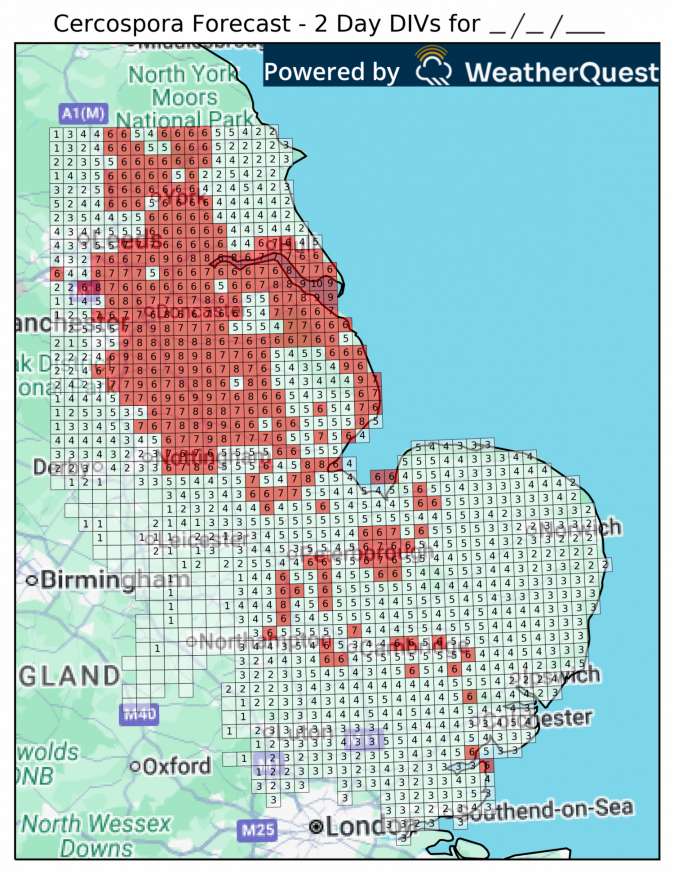Accurate Forecasts Mitigating The Many Threats To The Agricultural Sector
Client:
British Beet Research Organisation (BBRO) – Leading UK’s industry supported levy-body for research and knowledge exchange to support UK sugar beet growers and industry stakeholders.
Deliverable:
Implement a forecasting system for the Cercospora Leaf Spot disease and produce visual outputs for BBRO members to aid in fungicide operations.
Outcomes:
Keeping the sugar beet crop disease free, ensuring half of UK domestic sugar production is maintained.
The Challenge
Despite advances in agriculture, disease can still cause massive losses in crops, and with the changing climate, some diseases will begin to spread to new areas. One such disease threatening the UK is Cercospora Leaf Spot, caused by the fungus Cercospora beticola, which thrives in humid and warm environments. It impacts sugar beet, one of the most significant crops in the UK, with around 8 million tonnes grown annually. It causes black/brown spots to appear on the leaves, turning whole canopies brown over time, causing severe damage resulting in yield losses of as much as 50%. The fungus survives on dead plant material and other crops over winter and can then infect new plants during the following season by wind-borne processes.
BBRO undertakes research and knowledge exchange for sugar beet growers in the UK, aiming to help growers produce the healthiest and most valuable crop they can. One resource they provide is a Cercospora monitoring and risk forecast tool.
The 2-Day DIV Service
WeatherQuest helps develop this tool by producing 2-day daily infection values (DIVs), displayed on maps provided to BBRO, as shown below. From a model developed in North America, where they suffer from severe Cercospora infections, DIVs are calculated from maximum daily temperature between 20oC and 30oC (above this, the fungus can’t grow) and hours above a threshold humidity of 90%. The higher the value of both, the greater the risk. Crops are at very high risk of Cercospora development if the sum of two-day DIVs is 6 or more, shown by red boxes.

“WeatherQuest’s mapping is a vital tool to help in our fight against Cercospora Leaf Spot. It’s really helpful to be able to easily check the map each morning to help support our 2000+ growers.
Dr Alistair Wright,
When the DIVs reach the critical threshold we let our growers know through targeted text messages and alerts to prompt them to check their crops and take action if needed.”
Head of Crop Protection at BBRO
The Outcomes:
Protecting the Crop
Around half of the sugar produced in the UK comes from sugar beet, with the rest being refined from imported raw cane sugar. Therefore, protecting sugar beet crop is vital for the domestic sugar industry. With Cercospora only recently affecting the UK, many farmers may be unfamiliar with the fungus and how vital it is to control it early. The use of fungicides is highly regulated, and spraying must not be done on crops without infection to prevent fungicide resistance developing. By producing these maps for BBRO, it allows their growers to fully understand the conditions when their crops are at risk, when they need to check for infection and whether they need to spray.
The Outcomes:
Looking Ahead
Climate change is increasing the frequency of warm days within the UK, and as air temperature rises, the more moisture it can hold, leading to higher humidities. With a greater number of days reaching higher maximum temperatures, more days are therefore likely to reach the Cercospora humidity threshold. This means that Cercospora risk is increasing in the UK. With how destructive the disease can be, it is vital for institutions like BBRO to remain on the forefront of how the risk develops over time, both intra- and inter-seasonally.
Alongside these maps, a climatology of the season is also produced, including mapping rainfall temperature and humidity and comparing them to the DIV maps. This helps show some of the driving forces behind the highest risk days of any season and how they impacted the spatial risk of Cercospora. BBRO and their growers are then armed with the knowledge of conditions and time periods when crops are likely to be most at risk, aiding their preparations and increasing resilience for growing seasons to come.